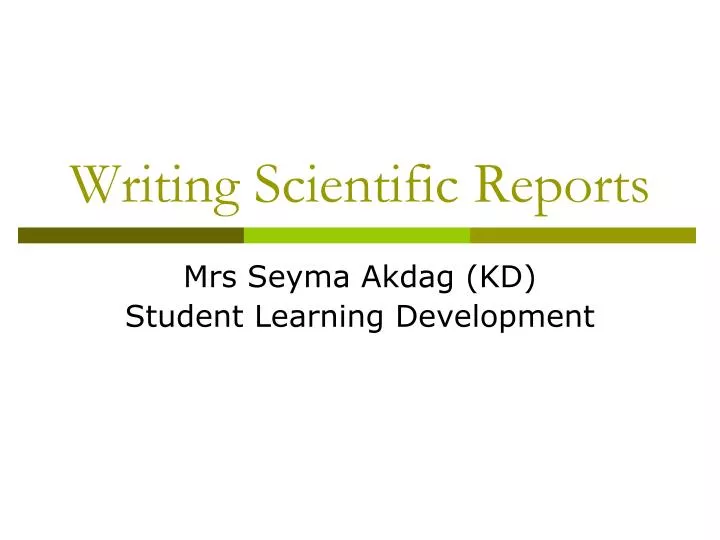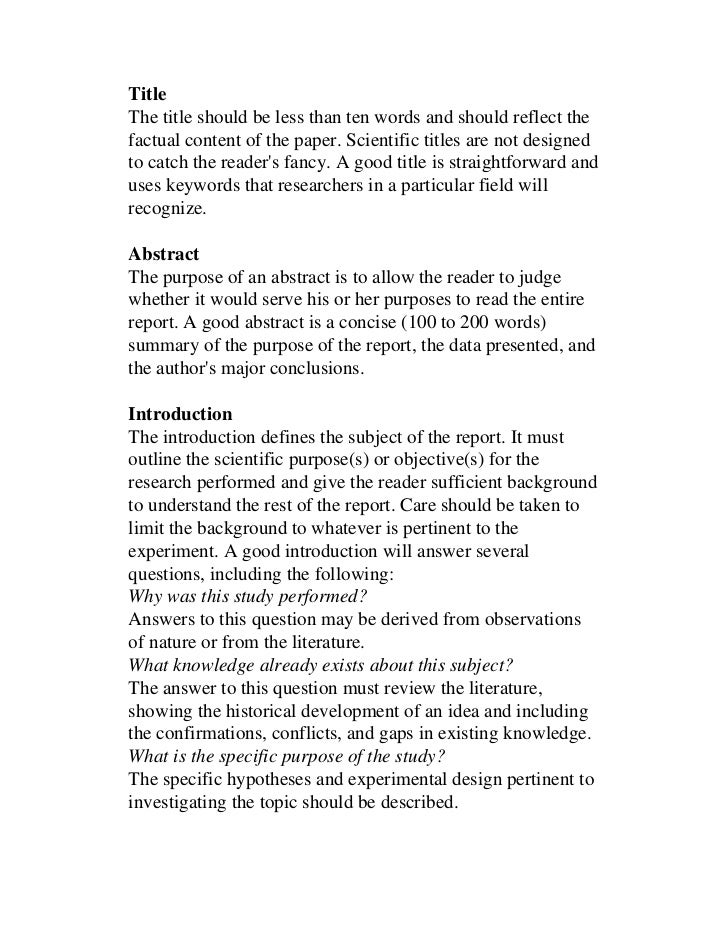
To write a successful manuscript, first be aware of the sentence structure you use. Write direct and short sentences. The average length of sentences in scientific writing is only about words. Include only one piece of information per sentence. Sentences should be constructed in short, factual bursts. Long and complicated sentencesFile Size: 1MB relationships unmistakable, which is important in reporting scientific information. If the clause can be omitted without leaving the modified noun incomplete, use which and enclose the clause within commas or parentheses; otherwise, use that. To be -- Frequently unnecessary. "The differences were [found] [to be] significant." WRITING A SCIENTIFIC REPORT "The question is," said Alice, "whether you can make words mean so many different things." "The question is," said Humpty Dumpty, " which is to be master - that's all." Lewis Carroll () Through the Looking Glass. 1. Introduction Scientific information is communicated in a variety of ways, through talks and seminars, through posters
Formatting Science Reports – The Writing Center – UW–Madison
Got to document an experiment but don't know how? In this post, we'll guide you step-by-step through how to write a scientific report and provide you with an example.
Is your teacher expecting you to write an experimental report for every class experiment? Are you still unsure about how to write a scientific report properly? We will guide you through all the parts of a scientific report, step-by-step. Scientific reports allow their readers to understand the experiment without doing it themselves. In addition, scientific reports give others the opportunity to check the methodology of the experiment to ensure the validity of the results.
A scientific report is written in several stages. We write the introduction, writing scientific reports, aim, and hypothesis before performing the experiment, record the results during the experiment, and complete the discussion and conclusions after the experiment.
But, before we delve deeper into how to write a scientific report, we need to have a science experiment to write writing scientific reports Read our 7 Simple Experiments You Can Do At Home article and see which one you want to do. Photosynthesis is a vital process for life. It occurs when plants intake carbon dioxide, water, and light, and results in the production of glucose and water. The light required for photosynthesis is absorbed by chlorophyll, writing scientific reports, the green pigment of plants, which is contained in the chloroplasts.
The glucose produced through photosynthesis is stored as starch, which is used as an energy source for the plant and its consumers. The aim identifies what is going to be tested in the experiment, writing scientific reports. This should be short, concise and clear.
The hypothesis is a prediction of the outcome of the experiment, writing scientific reports. You have to use background information to make an educated writing scientific reports. It is predicted that photosynthesis will occur only in leaves that are exposed to light and not in leaves that are not exposed to light.
This will be indicated by the presence or absence of starch in the writing scientific reports. Identify the hazards associated with the experiment and provide a method to prevent or minimise the risks. A hazard is something that can cause harm, and the risk is the likelihood that harm will occur from the hazard, writing scientific reports. Remember, you have to specify the type of harm that can occur because of the hazard.
It is not enough to simply identify the hazard. Wear closed, durable shoes to prevent injury from falling sharp instruments.
Methylated spirits are highly flammable and can cause burns or fires. Low Before using methylated spirits, ensure that all ignition sources such as Bunsen burners and matches are extinguished, writing scientific reports.
Minimise the volume of methylated spirits used. The rule of thumb is that you should write the method in a clear way so that readers are able to repeat the experiment and get similar results. Using a numbered list for the steps of your experimental procedure is much clearer than writing a whole paragraph of text. The steps should:. You also need to use past tense and passive voice when you are writing your method. Scientific reports are supposed to show the readers what you did in the experiment, not what you will do.
After you finish your steps, writing scientific reports, it is time to draw your scientific diagrams! Writing scientific reports are some rules for drawing scientific diagrams:. This is where you document the results of your experiment. Qualitative data is data that relates to qualities and is based on observations qualitative — quality. This type of data is descriptive and is recorded in words.
For example, the colour changed from green to orange, or the liquid became hot. Quantitative data refers to numerical data quantitative — quantity. This type of data is recorded using numbers and is either measured or counted. For example, the plant grew 5. You also need to record your results in an appropriate way. Most of the time, a table is the best way to do this, writing scientific reports. The discussion is where you analyse and interpret your results, writing scientific reports identify any experimental errors or possible areas of improvements.
That is, the relationship you observed between your independent and dependent variables. The independent variable is the variable that you are changing in the experiment. In this experiment, it is the amount of light that the leaves are exposed to. The dependent writing scientific reports is the variable that you are measuring in the experiment, In this experiment, it is the presence of starch in the leaves.
Explain how a particular result is achieved by referring to scientific knowledge, theories and any other scientific resources you find. Scientific explanation:. The presence of starch is indicated when the addition of iodine causes the leaf to turn dark purple. The results show that starch was present in the leaves that were exposed to light, while the leaves that were not exposed to light did not contain starch.
Provide an explanation of the results using scientific knowledge, theories and any other scientific resources you find. As starch is produced during photosynthesis, these results show that light plays a key role in photosynthesis. Validity refers to whether or not your results are valid. This can be done by examining your variables, writing scientific reports.
Identify the independent, dependent, controlled variables and the control experiment if you have one. The controlled variables are the variables that you keep the same across all tests e. the size of the leaf sample, writing scientific reports. It writing scientific reports untouched for the whole experiment. The independent variable of the experiment was amount of light that the leaves were exposed to the covered and uncovered geranium leafwhile the dependent variable was the presence of starch.
The controlled variables were the size of the leaf sample, the duration of the experiment, writing scientific reports, the amount of time the solutions were heated, and the amount of iodine solution used. Show that you repeated your experiments, cross-checked your results with other groups writing scientific reports collated your results with the class.
The reliability of the results was ensured by repeating the experiment 5 times and comparing results with other groups. Since other groups obtained comparable results, the results are reliable. Accuracy should be discussed if your results are in the form of quantitative data, and there is an accepted value for the result. Accuracy would not be discussed for our example writing scientific reports experiment as qualitative data was collected, however it would if we were measuring gravity using a pendulum:.
The measured value of gravity was 9. Possible improvements could be made by including control experiments, writing scientific reports. For example, testing whether writing scientific reports iodine solution turns dark purple when added to water or methylated spirits.
This would help to ensure that the purple colour observed in the experiments writing scientific reports due to the presence of starch in the leaves rather than impurities. The aim of the investigation was achieved, and it was found that light is required for photosynthesis to occur. This was evidenced by the presence of starch in leaves that had been exposed to light, and the absence of starch in leaves that had been unexposed.
These results support the proposed hypothesis. Use the scissors correctly and store them after use. Before using methylated spirits, ensure that all ignition sources such as Bunsen burners and matches are extinguished.
How to Write a Paper in a Weekend (By Prof. Pete Carr)
, time: 11:39Scientific Reports – The Writing Center • University of North Carolina at Chapel Hill

WRITING A SCIENTIFIC REPORT "The question is," said Alice, "whether you can make words mean so many different things." "The question is," said Humpty Dumpty, " which is to be master - that's all." Lewis Carroll () Through the Looking Glass. 1. Introduction Scientific information is communicated in a variety of ways, through talks and seminars, through posters relationships unmistakable, which is important in reporting scientific information. If the clause can be omitted without leaving the modified noun incomplete, use which and enclose the clause within commas or parentheses; otherwise, use that. To be -- Frequently unnecessary. "The differences were [found] [to be] significant." The Writing Center Scientific Reports What this handout is about This handout provides a general guide to writing reports about scientific research you’ve performed. In addition to describing the conventional rules about the format and content of a lab report, we’ll also attempt to convey why these rules exist, so you’ll get a clearer, more
No comments:
Post a Comment